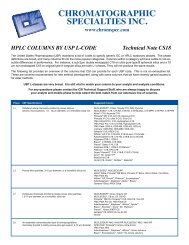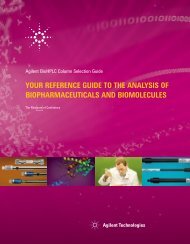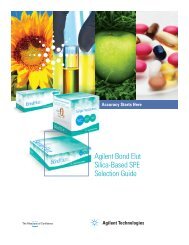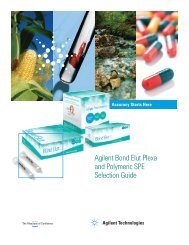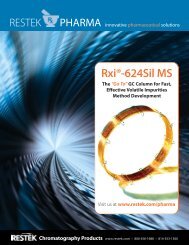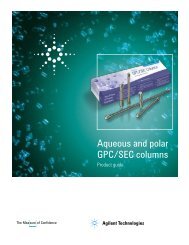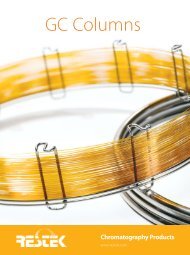Optimizing the Analysis of Volatile Organic Compounds
Optimizing the Analysis of Volatile Organic Compounds
Optimizing the Analysis of Volatile Organic Compounds
You also want an ePaper? Increase the reach of your titles
YUMPU automatically turns print PDFs into web optimized ePapers that Google loves.
16<br />
EPA Update<br />
The US EPA promulgated update III <strong>of</strong> Test<br />
Methods for Evaluating Solid Waste (SW-<br />
846). This 1997 update deleted <strong>the</strong> previous<br />
EPA purge and trap Method 5030A, “Sample<br />
Preparation <strong>of</strong> <strong>Volatile</strong> <strong>Organic</strong> <strong>Compounds</strong> for<br />
Purge and Trap <strong>Analysis</strong>” and replaced it with<br />
Method 5035, “Closed System Purge and Trap<br />
and Extraction for <strong>Volatile</strong> <strong>Organic</strong>s in Soil and<br />
Waste Samples.” Method 5035 involves<br />
extensive fieldwork and raises MDLs for soil<br />
samples; however, accuracy is improved.<br />
Previously, soil samples were collected using<br />
PTFE -lined screw-cap containers and stored<br />
at 4°C, with a 14-day maximum holding time.<br />
Once <strong>the</strong> samples were in <strong>the</strong> laboratory, 5g<br />
aliquots <strong>of</strong> soil were added to 5mL <strong>of</strong> reverse<br />
osmosis (RO) water. The volatiles in <strong>the</strong>se<br />
samples exit <strong>the</strong> soil matrix and leak from <strong>the</strong><br />
container. Method 5035 requires samples to<br />
be collected and preserved in <strong>the</strong> field at <strong>the</strong><br />
time <strong>of</strong> sampling, using methanol and a stirbar.<br />
<strong>Volatile</strong>s dissolved in <strong>the</strong> methanol are<br />
less likely to escape. The seal is not broken<br />
until <strong>the</strong> time <strong>of</strong> analysis, thus minimizing<br />
analyte loss through evaporative mechanisms.<br />
Sodium bisulfate is used to prevent biodegradation<br />
<strong>of</strong> VOCs. Unlike HCl preservation, sodium<br />
bisulfate does not break down 2chloroethyl-vinyl-e<strong>the</strong>r.<br />
This greatly improves<br />
<strong>the</strong> accuracy <strong>of</strong> analytical results from soil<br />
samples because evaporative loss occurs<br />
almost immediately in soils that are not preserved<br />
in methanol. Disadvantages include <strong>the</strong><br />
higher detection limits and <strong>the</strong> problems associated<br />
with purging higher percentages <strong>of</strong><br />
methanol.<br />
Flushing <strong>the</strong> trap attachment area with<br />
methanol. Repeat several times.<br />
www.restekcorp.com<br />
Figure 11.<br />
No measurable response for brom<strong>of</strong>orm (9), combined with a greatly diminished response<br />
for 1,1,2,2-tetrachloroethane (10), strongly indicates a contaminated transfer line.<br />
20m, 0.18mm ID, 1.0µm Rtx ® -502.2 column (cat.# 40914), 4ppb <strong>of</strong> VOA standards.<br />
Oven temp.: 35°C (hold 5 min.) to 180°C @ 6°C/min.<br />
Inj. / det. temp.:<br />
Linear velocity:<br />
to 210°C @ 20°C/min. (hold 5 min.)<br />
100°C / 280°C<br />
20cm/sec. set @ 35°C<br />
Purge & trap: Tekmar 3000<br />
Purge: 11 min.<br />
Trap pressure control: 6psi<br />
Desorb preheat:<br />
Desorb time:<br />
Detector:<br />
Split ratio:<br />
250°C<br />
2 min.<br />
MS<br />
40:1<br />
Scan range:<br />
Trap:<br />
35-260AMU<br />
Vocarb 4,5<br />
14,15<br />
2,3<br />
12,13<br />
8<br />
18<br />
23<br />
20<br />
17 19<br />
Desorb temp.:<br />
Desorb flow rate:<br />
3000<br />
260°C<br />
20mL/min.<br />
1<br />
6<br />
7 16 21<br />
22<br />
1. chlorobenzene<br />
2. ethylbenzene<br />
3. 1,1,1,2-tetrachloroethane<br />
4. m-xylene<br />
5. p-xylene<br />
6. o-xylene<br />
7. styrene<br />
8. isopropylbenzene<br />
9. brom<strong>of</strong>orm (not detected)<br />
10. 1,1,2,2-tetrachloroethane<br />
11. 1,2,3-trichloropropane<br />
12. propylbenzene<br />
Instructions for Cleaning Purge and Trap Concentrators<br />
We developed <strong>the</strong>se instructions using Tekmar LSC 2000 and 3000 concentrators. Always<br />
remember to use safety glasses when working in <strong>the</strong> laboratory.<br />
1. Keep <strong>the</strong> instrument power on and turn <strong>the</strong> line heaters <strong>of</strong>f. Set all temperatures to <strong>the</strong> <strong>of</strong>f<br />
position. WAIT UNTIL HEATED ZONES HAVE COOLED.<br />
2. Make sure <strong>the</strong> unit is in standby mode.<br />
3. Disconnect <strong>the</strong> purge and trap vessel.<br />
13. bromobenzene<br />
14. 1,3,5-trimethylbenzene<br />
15. 2-chlorotoluene<br />
16. 4-chlorotoluene<br />
17. tert-butylbenzene<br />
18. 1,2,4-trimethylbenzene<br />
19. sec-butylbenzene<br />
20. p-isopropyltoluene<br />
21. 1,3-dichlorobenzene<br />
22. 1,4-dichlorobenzene<br />
23. n-butylbenzene<br />
24. 1,2-dichlorobenzene<br />
4. Flush methanol into <strong>the</strong> area where <strong>the</strong> top <strong>of</strong> <strong>the</strong> trap attaches, using a 5mL syringe<br />
without a needle (i.e., a Luer-lock syringe - see photo). This is <strong>the</strong> area where <strong>the</strong> purge<br />
vessel attaches to <strong>the</strong> purge and trap. You should see methanol coming out <strong>of</strong> <strong>the</strong> mount.<br />
5. Clean <strong>the</strong> mount, using a tissue. The mount is ei<strong>the</strong>r nickel- or gold-plated, so be careful<br />
not to scratch <strong>the</strong> surface. If you cannot clean <strong>the</strong> mount, it may need to be replaced.<br />
6. Clean <strong>the</strong> purge vessel with methanol, <strong>the</strong>n with ultra-pure water. Do not use soap. You<br />
may use a brush.<br />
7. Increase purge and trap temperatures to normal operating conditions and hold for two<br />
hours, with no trap or purge vessel installed.<br />
8. Install an empty trap. Do not use an old trap with <strong>the</strong> packing removed; particles <strong>of</strong> trapping<br />
material may end up in <strong>the</strong> concentrator. If an empty trap is not available, refer to <strong>the</strong><br />
next paragraph. With <strong>the</strong> empty trap in place, attach all lines, including <strong>the</strong> line to <strong>the</strong><br />
purge vessel. Desorb for at least one hour with <strong>the</strong> transfer line disconnected from <strong>the</strong> column.<br />
This will help to drive any methanol remaining from step 6 out <strong>of</strong> <strong>the</strong> system.<br />
If you do not have an empty trap, disconnect <strong>the</strong> transfer line from <strong>the</strong> column, connect<br />
<strong>the</strong> purge vessel and all lines, and install an old trap. Desorb for one hour.<br />
9. Install and condition a new trap and run blanks until a clean baseline is achieved.<br />
If you are still having activity problems after following this procedure, please contact <strong>the</strong><br />
Restek Technical Service Team via email at support@restekcorp.com or via phone at<br />
800-356-1688 or 814-353-1300, ext. 4.<br />
11<br />
10<br />
min. 20<br />
c-gram #216<br />
24<br />
25<br />
Permission to publish this chromatogram<br />
granted by Anne Williams, Tekmar Company.





